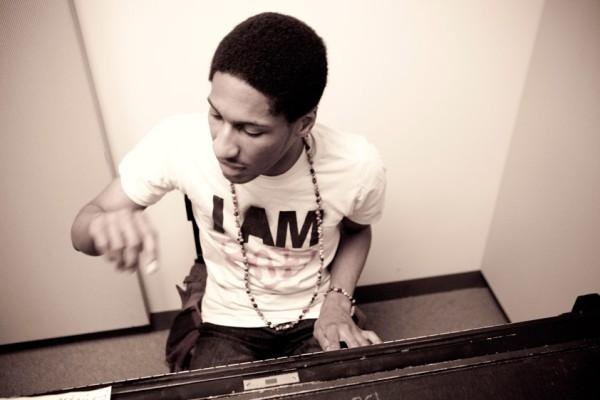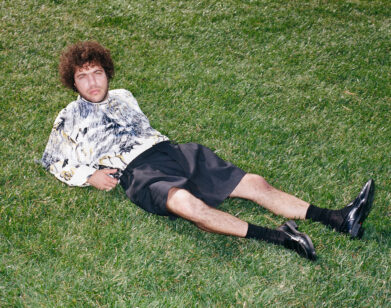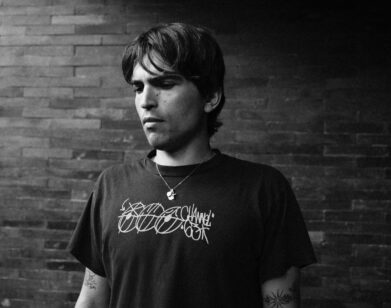Treme in Real Life: Jonathan Batiste

ABOVE: JONATHAN BATISTE. IMAGE COURTESY OF INGRID HERTFELDER
Jonathan Batiste’s melodica—a harmonica-keyboard fusion he fondly named the “harmonabord”—bleeds New Orleans soul through the streets of New York City. The skinny, stylish Juilliard graduate comes from a long line of famed Louisiana performers; and he captures old New Orleans spirit with an edgy, big-city flair. A genuine performance artist, Batiste’s liveliness never wanes in the spotlight.
Recently appointed the Artistic Director at Large for the National Jazz Museum in Harlem, Batiste’s band, Stay Human, started out with impromptu street performances, or “Love Riots.” In 2011 they released MY NY, an album recorded entirely within the NYC subway system. Between tours, solo gigs, and educational programs for the museum, Batiste and the Stay Human band continue their Love Riots throughout the city.
In anticipation of his biggest show yet, a blowout at The Cutting Room this Friday, Jonathan sat down with Interview to discuss the band, HBO’s Treme, and the growing importance of music education.
JAMES A. EMMERMAN: So how are you?
JONATHAN BATISTE: All right, I’m stuck in Utah.
EMMERMAN: Ah, yeah? The snow is almost covering the cars here in Boston, I haven’t left my apartment.
BATISTE: [laughs] Man… I’m sorry to hear that.
EMMERMAN: Your family is pretty famous down south, right?
BATISTE: Yeah, it’s actually New Orleans’ largest musical family. The show Treme on HBO is based off of us… the characters are real people.
EMMERMAN: Right, right. So how did the show Treme come about? Was that just something HBO kind of came to you all about or—
BATISTE: Well, it’s something that David Simon conceptualized with the intent of documenting post-Katrina New Orleans. Thinking about New Orleans culture, my family just ended up being a shoo-in for that kind of a depiction.
EMMERMAN: And so what is your role in the show? I watched the clip from your website, how often are you in it?
BATISTE: I’m in the show every season, starting with the second. And I do a lot of composition for it. I’ve had about four or five compositions in the show—
EMMERMAN: Wow.
BATISTE: And I’m acting in the show as myself. I do different cameos and have been in about four or five different episodes.
EMMERMAN: So how is that? Is it weird acting as yourself?
BATISTE: Yeah it’s kind of strange, ’cause you know they give me lines and I’m… myself.
EMMERMAN: So for right now though, is your main focus the Stay Human band?
BATISTE: Yeah, I perform with the band most of the time, 90% of the shows I do are with Stay Human. We always are performing together, and if we’re not—like just last month I was in Lincoln Center Theater, I was a special guest for Wynton Marsalis… and I was also in Italy playing solo piano—
EMMERMAN: Wow, nice! Well you were also recently named as one of the Top 30 Under 30 Most Influential People in the Art World, right?
BATISTE: Right.
EMMERMAN: How did that come about?
BATISTE: It was interesting because I didn’t know about the article until after it was written and published—
EMMERMAN: Oh, really?
BATISTE: Once it was published, I saw it and I was like, “Wow, I wonder where they first saw my work,” because I didn’t know. I think a lot of it was because around that time I was guest speaker at a TED Conference, I did some stuff on CNN, and I was named Artistic Director At Large at the National Jazz Museum in Harlem. So there was a lot of stuff going on that I think brought public attention. And, of course, I’m always playing shows in New York, so they had a chance to see me in the various situations I had set up.
EMMERMAN: How did you meet everyone in the Stay Human band?
BATISTE: Yeah, so it’s me and three other guys. The drummer [Joey Saylor] and I met more than eight years ago when we were high school students, and that’s when we first formed the band.
EMMERMAN: I didn’t realize it went that far back.
BATISTE: Yeah, it goes—[laughs] He’s not even from New Orleans, in fact. He’s from Pittsburgh, and he was visiting New Orleans when we met. It was just the kind of thing where we had natural chemistry, and it just worked out. So from there, about five years ago, I met the saxophonist [Eddie Barbash] when he was a freshman at Juilliard and I was studying in the Master’s degree program, and then I met the tuba player [Ibanda Ruhumbika] at Juilliard and he was in the classical division, and he joined the band about two years ago. So we all went to Juilliard … and I guess the band really came to being about two years ago when we started to play in the subways in New York City almost every day of the summer.
EMMERMAN: Yeah that sort of kicked everything off, right?
BATISTE: Right. It was one of those moments of “Wow, this is a really good dynamic. “The chemistry of the band is great, and it was just something that we all wanted to keep doing.
EMMERMAN: In going from those sort of impromptu performances to a structured tour, how do you keep that same energy and vibe in a more typical stage and audience kind of setting?
BATISTE: Well, with the audience, I always say it’s about giving the people an experience. And what the experience is about, it transcends just the music, and genre, and the venue. It’s about the people coming together to share a profound and transformative moment. So that means the listener is actively engaged, and the listener is a part of the show, they’re a part of the experience. But when we go into venues, I like to go early if I can, see a few shows in the venue before I play there, and just get a feel for how we can transform the venue into an experience for everyone that’s going to come through the door.
EMMERMAN: Wow, that is actually a really, really cool idea. So tell me about your show coming up at the Cutting Room, I know it’s one of your biggest shows yet, right? It’s a blowout?
BATISTE: Oh yeah, it’s like—well, the Cutting Room, it has the capacity to hold more than any of the venues we’ve played before. I mean we’ve played some of the venues like Joe’s Pub and Rockwood and sold those out every time, but those are like 180 to 200, whereas the Cutting Room is 700.
EMMERMAN: Wow.
BATISTE: And you know at Joe’s Pub or Rockwood, we’ll play and the show will spill out into the street, and we’ll do what we call a Love Riot. That’s a parade in the street where the crowd from the show, and even more people, join in. So imagine with 700 people… [laughs] I’m not sure what’s going to happen.
EMMERMAN: You’re from New Orleans, and you’re up in New York, I’m wondering what your plans for the future are? Do you think you’re ever going to head back to Louisiana, or are you pretty much going to stay up in New York and work on music?
BATISTE: Well, the Batiste Cultural Arts Academy, which is a charter school that my family has, they’re doing some great things. It was just established about a year and a half ago, and I want to get involved in that at some point, but I don’t know if I’ll move back to New Orleans anytime soon just because of my work at the Jazz Museum in Harlem. There’s no set plan, but there’s a whole lot of different opportunities.
EMMERMAN: What exactly do you do at the Jazz Museum right now?
BATISTE: I’m the Artistic Director at Large, I’m sort of like a traveling ambassador, I’ll do things like the Jazz Is Now program, or Spontaneous Combustion, which is a performance series. But I’m also touring a lot. I just came from Brigham Young University, which is why I’m in Utah. I did a lecture there for two days on jazz and the art of civic life. So when I do something like that, it’ll be a Jazz Museum event on the road.
EMMERMAN: So do you see yourself as more of a traveling teacher and lecturer, or as a musician, in terms of the long run?
BATISTE: I always want to be doing both. I think in this generation institutionalizing the art form and spreading it to the younger generation through education is really important for all artists to have some hand in. Right now in popular culture and the mainstream, it’s not a big part at all. I think education by young artists talking to young people, not just older people talking to young people, it gives an experience never felt before. I think over the years it will do a lot for the music.
JONATHAN BATISTE IS PLAYING AT THE CUTTING ROOM IN NEW YORK CITY AT 9 PM, FEBRUARY 15. FOR MORE ON THE ARTIST, VISIT HIS WEBSITE.






